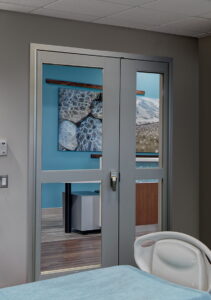Flexible Openings Benefit Patients & Providers

Healthcare design can present unique and difficult challenges to facility managers and architects alike. Not only does the building have to be accessible and intuitively navigable for patients and visitors, but it also has to accommodate the particular demands asked of medical professionals. On the one hand, when designed well, buildings can make both seeking and providing healthcare easier and more equitable. But on the other, a poorly designed built environment can hinder the staff’s ability to perform their job well and frustrate or discourage patients from seeking care. This can lead to high attrition rates in the medical field and more costly medical procedures if routine check-ups are missed.
Being a critical link between designers and building occupants, healthcare facility managers can help create more intuitive and adaptable buildings. However, specifying architectural elements that contribute to these goals may sometimes seem like a delicate balancing act, in which facility managers have to juggle necessary features and optional but beneficial ones.
One way for facility managers to help create a more supportive healthcare environment is to choose doors that benefit both patients and providers. The right door systems can create more accessible and adaptable spaces. They can also enhance the efficiency with which medical professionals can provide care. All these benefits contribute to a built environment that can ease the stress of both patients and providers.
Doors that open to a variety of widths to accommodate different needs can enhance accessibility and efficiency. They can also help create an adaptable built environment, helping healthcare settings respond to sudden and gradual changes in patient needs. As such, they can be an excellent candidate for improving the entire functionality of a healthcare building – benefitting everyone from the patient to the staff.
Designing With Flexibility in Mind
Healthcare spaces need to be adaptable to accommodate different types of patients, functions and equipment. This was quite apparent during the height of the COVID-19 pandemic when hospitals and clinics were hit with surges of patients and had to implement new protocols rapidly to deal with a serious and highly transmissible virus.
In addition to unforeseeable circumstances, it is likely a healthcare space will serve multiple specialties and purposes over its service life. Further, major advances in technology and new patient needs may change how a healthcare setting operates. All these situations may require spaces to flex. Flexible designs that accommodate either known or unknown potential future factors are critical to healthcare spaces functioning well.

Doors that provide flexible opening sizes can help spaces adapt to future changes. For instance, swing doors with unequal leaves allow acute care patient rooms, med-surg patient rooms, hospital imaging suites, operating suites and more to accommodate the movement of large equipment without having to sacrifice square footage to large swing arc trajectories during daily use. This translates to rooms that can accommodate more necessary supplies and more freedom of movement, both of which make providing quality care easier.
Likewise, these same benefits also enhance accessibility. By allowing more room for movement, these doors support spaces that are easily navigable for those who use mobility assistive devices. Large swing arc trajectories also increase approach clearances, which can make access difficult for patients and staff with disabilities. By reducing the swing arc trajectory for daily use and allowing a larger opening for special accommodations, doors with unequal leaves can support a flexible healthcare design. Facility managers who incorporate them into their buildings can support both the medical staff and the patients they serve.
Repeatable Units Accumulate Benefits
While a single door may not make a noticeable difference on the functionality of a space, multiple doors across an entire medical facility can have an accumulated effect on how the facility can support its occupants. For example, a recent renovation of the Pacific Medical Centers Gately-Ryan Building, in Renton, Wash., was able to use the saved square footage to add an additional exam room for every 11 originally planned. The extra rooms help ease scheduling conflicts.
When these types of doors include flexible opening capabilities, like telescoping sliding door options, they can save even more space while also being able to provide wider openings to accommodate large equipment and patient beds. Swing doors with unequal pairs of leaves provide similar benefits.
Optimizing useable square footage can help facilitate easier movement between rooms and wings of hospitals, making back-to-back appointments more feasible for medical professionals. It can also relax scheduling demands by providing more patient rooms that can accommodate movable beds and larger equipment. Both benefits provide value, especially when the systems are specified throughout the built environment.
Choosing a Door That’s an Opening Not an Obstacle
Planning and operating healthcare settings that help medical professionals provide care and supports the varying needs of patients and visitors is no simple task. Further complicating the matter, knowing that a medical building’s uses will change with patient needs and technological advances can make specifying the right architectural systems feel like trying to predict the future.
However, doors that provide flexible openings contribute both to an environment ready to adapt to the ever-shifting nature of healthcare and to a design that accommodates the unique pressures patients and providers feel in the present. When these doors are intuitive to operate and able to meet a range of design considerations, they can be a step toward a built environment that works for its occupants now and in the future. Taking these concerns into account can help facility managers improve patient satisfaction and staff morale. Specifying doors with flexible openings can be an ideal solution for these
Tysen Gannon, LEED AP, AD Systems has more than 15 years of experience in the architectural products industry, including roles in sales, product management, research and marketing, with a focus on glass and glazing, fenestration and façade systems. Website: www.specadsystems.com.
